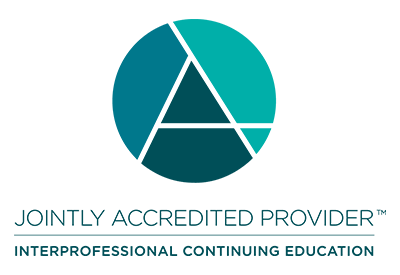- Credit Amounts:
- CME: 1.75
- CPE: 1.75
- Other: 1.75
- ASWB ACE: 1.75
- CNE: 1.75
- Cost: Free
- Release: Jan 17, 2024
- Expires: Jan 17, 2027
- Estimated Time to Complete:
1 Hour(s) 45 Minutes -
Average User Rating:
(5 Ratings)
Faculty
 Melanie Dicks, PharmD
Melanie Dicks, PharmDClinical Assistant Professor, Pharmacy Practice and Science
University of Kentucky College of Pharmacy
Lexington, Kentucky
 Julie B. Perry, DNP
Julie B. Perry, DNPDirector Medical/Clinical Practice
Bluegrass Community Health Center
Lexington, Kentucky
Psychiatric Mental Health/Family Nurse Practitioner
Eastern State Hospital/Central Kentucky Recovery Center Managed by University of Kentucky
Lexington, Kentucky
Needs Statement
According to the American Society of Addiction Medicine, addiction is a treatable, chronic medical disease involving complex interactions among brain circuits, genetics, the environment, and an individual’s life experiences. People with addiction use substances or engage in behaviors that become compulsive and often continue despite harmful consequences. No single treatment is appropriate for everyone but treatment needs to be readily available and attend to multiple needs of the individual, not just his or her drug abuse and medications are an important element of treatment for many patients, especially when combined with counseling and other behavioral therapies. According to the National Survey on Drug Use and Health (NSDUH), 19.7 million American adults (aged 12 and older) battled a substance use disorder in 2017. Almost 74% of adults suffering from a substance use disorder in 2017 struggled with an alcohol use disorder and about 38% of adults in 2017 battled an illicit drug use disorder. That same year an estimated 20.7 million people age 12 and older needed treatment for a substance use disorder. Only 4 million people received treatment, or about 19% of those who needed it. (www.drugabuse.gov).Target Audience
Healthcare professionals in a primary care setting.Objectives
Upon completion of this educational activity, you will be able to:1. Define Addiction
2. Identify ways to manage addiction as a chronic disease
3. Discuss the effect of drugs on the brain including dopamine and other neurotransmitters
4. Demonstrate the process for initiating treatment for Opiate Use Disorder (OUD) with buprenorphine and extended release naltrexone
5. Name 3 medications FDA approved to treat Alcohol Use Disorder
6. Discuss other substances and current treatment recommendations
7. Develop individualized plans of care for substance use treatment including medications and behavioral interventions
8. Review the process for treating opiate use disorder with Naltrexone vs Buprenorphine
9. Identify how to obtain a waiver to prescribe buprenorphine and additional training resources
Accreditation
In support of improving patient care, University of Kentucky HealthCare CECentral is jointly accredited by the Accreditation Council for Continuing Medical Education (ACCME), the Accreditation Council for Pharmacy Education (ACPE), and the American Nurses Credentialing Center (ANCC), to provide continuing education for the healthcare team.
CMEThis enduring material is designated for a maximum of 1.75 AMA PRA Category 1 Credit(s)™. Physicians should claim only credit commensurate with the extent of their participation in the activity.
This training has been approved by the KBML as meeting the statutory requirements of HB1. 0521-H1.0-UK13C
IPE Competencies
- Roles/ Responsibilities
- Interprofessional Communication
This knowledge-based activity will award 1.75 contact hours (0.175 CEUs) of continuing pharmacy education credit in states that recognize ACPE providers. Other
UK Healthcare CECentral certifies this activity for 1.75 hours of participation. ASWB ACE
As a Jointly Accredited Organization, UK HealthCare CECentral is approved to offer social work continuing education by the Association of Social Work Boards (ASWB) Approved Continuing Education (ACE) program. Organizations, not individual courses, are approved under this program. State and provincial regulatory boards have the final authority to determine whether an individual course may be accepted for continuing education credit. UK HealthCare CECentral maintains responsibility for this course. Social workers completing this course receive 1.75 clinical continuing education credits.CNE
The maximum number of hours awarded for this Continuing Nursing Education activity is 1.75 nursing contact hours.
Faculty Disclosure
All planners, faculty, and others in control of educational content are required to disclose all their financial relationships with ineligible companies within the prior 24 months. An ineligible company is defined as one whose primary business is producing, marketing, selling, re-selling, or distributing healthcare products used by or on patients. Financial relationships are relevant if the educational content an individual can control is related to the business lines or products of the ineligible company.None of the planners, faculty, and others in control of educational content for this educational activity have relevant financial relationship(s) to disclose with ineligible companies.
The material presented in this course represents information obtained from the scientific literature as well as the clinical experiences of the speakers. In some cases, the presentations might include discussion of investigational agents and/or off-label indications for various agents used in clinical practice. Speakers will inform the audience when they are discussing investigational and/or off-label uses.
Disclosure of a relationship is not intended to suggest or condone commercial bias in any presentation, but it is made to provide participants with information that might be of potential importance to their evaluation of a presentation.
